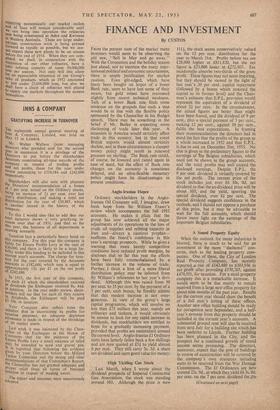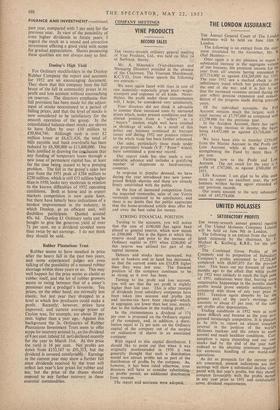FINANCE AND INVESTMENT
By CUSTOS FROM the present state of the market many investors would seem to be observing the old saw, "Sell in May and go away." With the Coronation and the holiday season just ahead, not to mention the many inter- national political and economic uncertainties, there is ample justification for market caution. Even gilt-edged, which have lately been bought on hopes of a lower Bank rate, seem to have lost some of their steam, but gold mines have recovered slightly from recent technical weakness. Talk of a lower Bank rate finds some credence on the grounds that such a step would be in line with the flexible policy sponsored by the Chancellor in his Budget speech. There may be something - in the belief if Mr. Butler is expecting some slackening of trade later this year. A recession in America would certainly affect trade in this country, but in that event British exports would almost certainly decline, and in these circumstances a cheaper money policy might result in renewed pressure on sterling. The Bank rate could, of course, be lowered and raised again in case of need, but the effect of Bank rate changes on the economy is sometimes delayed, and an ultra-flexible monetary policy might have 'its disadvantages in present conditions.
Anglo-Iranian Hopes Ordinary stockholders in the Anglo- Iranian Oil Company will, I imagine, draw fresh hope from Sir William Fraser's review which accompanies the full 1952 accounts. He makes it plain that the group has now achieved all the major adjustments of its operations to the loss of crude oil supplies and refining capacity in Iran and—always a cautious prophet— reaffirms the board's confidence in this year's earnings prospects. While he gives a warning that more keenly competitive conditions have reduced profit margins, he discloses that so far this year the effects have been fully counterbalanced by a further increase in the volume of trade. Further, I think a hint of a more liberal distribution policy may be inferred from Sir William's references to last year's divi- dend. Although this was raised from 30 per cent. to 35 per cent. by the payment of a 5 per cent. cash bonus, he frankly admits that this modest increase is not over- generous. In view of the group's large capital programme, which will involve no less than £75 million this year, mainly on refineries and tankers, it would obviously be unwise to look for any rapid increase in dividends, but stockholders are entitled to hope for a gradually increasing payment, provided that profits are maintained around the current level. Anglo-Iranian £1 Ordinary units have latterly fallen back a few shillings and are now quoted at £5/ to yield almost 6 per cent. They still carry 3s. 3d. a share net dividend and seem good value for money.
High Yielding Gas Stock Last March, when I wrote about the dividend prospects of Imperial Continental Gas Association, the stock was standing around 103. Although the price is now 1 1 11, the stock seems conservatively valued on the 12 per cent, distribution for the year to March 31st. Profits before tax are £28,000 higher at £811,820, but the net figure is £23,000 lower at £272,307. Tax incidentally absorbs two-thirds of the gross profit. These figures may not seem inspiring, but they should be viewed in the light of last year's 20 per cent. capital repayment (followed by a bonus which restored the capital to its former level) and the Chair- man's estimate that E.P.L. provision would represent the equivalent of a dividend of about 21 per cent. In the circumstances, the actual figures are better than might have been feared, and the dividend of 9 per cent., plus a special payment of 3 per cent., making 12 per cent., against 10 per cent., fulfils the best expectations. In framing their recommendations the directors had in mind the fact that the profits of the group as a whole increased in 1952 and that E.P.L. is due to end on December 31st, 1953. No clue is given in the preliminary figures to the earnings of the Belgian subsidiaries, which need not be shown in the group accounts, and the total profits may well exceed the disclosed earnings. Despite E.P.L. the 9 per cent. dividend is virtually covered by the net profit. The current price of the stock includes just over £6 10s. Od. net dividend so that the ex-dividend price will be about 105, and the yield, ignoring the special dividend, over 81 per cent. The special dividend suggests confidence in the outlook, and I should not oppose a purchase at this price, but it may be advisable to wait for the full accounts, which should throw more light on the earnings of the important Belgian subsidiaries.
A Sound Property Equity When the outlook for many industries is blurred, there is much to be said for an investment in the more "sheltered" con- cerns, such as the leading property com- panies. One of these, the City of London Real Property Company, has recently reported _a rise of £142,480 to £393,936 in net profit after providing £570,205, against £479,551, for taxation. For a staid property company this is a remarkable increase. It would seem to be due mainly to rentals received from a large new office property for about nine months of the past year. Results for the current year should show the benefit of a full year's letting of these offices. Another new office building should be ready for occupation next September, and a half- year's revenue from this property should be included in the current year's accounts. A substantial ground rent will also be received from next July for a building site which has been underlet to Lloyds. Further building has been planned in the City, and the prospect for a continued growth of rental income seems promising. The directors, moreover, expect that the cost of buildings in course of construction will be covered by the company's own resources including sums to be received from the War Damage Commission. The £1 Ordinaries are now around 22s. 9d., at which they yield £6 3s. Od. per cent. on the 7 per cent. dividend for4he (Continued on next page)
FINANCE AND INVESTMENT—continued,
past year, compared with 5 per cent for the previous year. In view of the possibility of even higher dividends in future years, I regard the stock as a sound and attractive investment offering a good yield with scope for gradual appreciation. Shares possessing these qualities are not always easy to find.
Dunlop's High Yield For Ordinary stockholders in the Dunlop Rubber Company the report and accounts for 1952 are an encouraging document. They show that this company bore the full brunt of the fall in commodity prices in its profit and loss account without encroaching on reserves. The directors emphasise that full provision has been made for the adjust- ment of stocks necessitated in a period of falling prices, and that the level of stocks is now considered to be satisfactory for the smooth operation of the group. In the consolidated balance-sheet stocks are shown to have fallen by over £10 million to £50,864,746. Although cash is over £2 million lower at £6,621,426, the total of bills payable and bank overdrafts has been reduced by £6,500,000 to £13,400,000. One feels justified in drawing the conclusion that any funding of temporary loans through a new issue of permanent capital has, at least for the time being, ceased to be 'a pressing problem. The fall in the group's sales last year from the 1951 peak of £284 million to £250 million, which is still £53 million higher than in 1950, looks very moderate in relation to the known difficulties of 1952 operating conditions. Both at home and in export markets competition is now quite keen, but there have latterly been indications of a modest improvement in the industry, in which Dunlop, as an efficient unit, will doubtless participate. Quoted around 45s. 6d. Dunlop £1 Ordinary units can be bought to give the generous yield of over 74 per cent. on a dividend covered more than twice by net earnings. I do not think they should be sold.
Rubber Plantations Trust Rubber seems to have steadied in price after the heavy, fall in the past two years, and some experienced judges are even talking of the possibility of a natural rubber shortage within three years or so. This may well happen for the price seems as elastic as rubber itself, and the lot of rubber .growers seems to swing between that of a miser's pensioner and a prodigal's favourite. Tea prices, on the other hand, are ndrmally less elastic, but last year they dropped to a level at -which few producers could make a profit. Recently, however, prices have improved; and current average prices of Ceylon teas, for example, are about 20 per cent. higher than a year ago. Against this background the 2s. Ordinaries of Rubber Plantations Investment Trust seem to offer scope for recovery around ls., ex the dividend of 8 per cent. (about Id. net) declared recently for the year to March 31st. At this price the yield is 16 per cent. Net profits are down from £153,167 to £91,313, but the dividend is covered comfortably. Earnings in the current year may show a further fall since dividends received by the trust will reflect last year's low prices for rubber and tea; but the price of the shares should respond to any further recovery in these essential commodities.



































 Previous page
Previous page